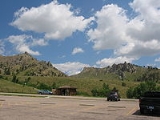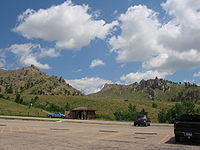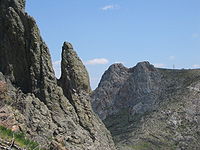
Bear Butte
Encyclopedia
Bear Butte is a geological butte
feature located in western South Dakota
, United States, that was established as a State Park
in 1961. An important landmark and religious site for the Plains Indians
tribes long before Europe
ans reached South Dakota, Bear Butte is called Mathó Pahá, or Bear Mountain, by the Lakota, or Sioux
. To the Cheyenne
, it is Noahȧ-vose ("giving hill") or Náhkȯhe-vose ("bear hill"), the place where Ma'heo'o (God) imparted to Sweet Medicine, a Cheyenne prophet, the knowledge from which the Cheyenne derive their religious, political, social, and economic customs. The mountain is sacred to many indigenous peoples, who make pilgrimages to leave prayer cloths and bundles tied to the branches of the trees along the mountain’s flanks. Other offerings are often left at the top of the mountain. The site is associated with various religious ceremonies throughout the year. The mountain is a place of prayer, meditation, and peace.
The park includes a campsite south of South Dakota Highway 34
where horseback riding, fishing, and boating are permitted. On the summit side of Highway 34, a moderately sized herd of buffalo
roams the base of the mountain. An education center and a summit trail are available. Official park policy advises visitors to Bear Butte to respect worshippers and to leave religious offerings undisturbed. Park fees are waived for those undertaking religious activities.
In 2007, Gov. Mike Rounds of South Dakota announced a proposal to use state, federal and private money to buy a perpetual easement in order to prevent commercial and residential development of some land on the western side of Bear Butte. This would cost more than $1 million, but would prevent development of nuisance businesses (such as potentially lucrative biker bars) on ranch land near the mountain on the northern edge of the Black Hills.


 Bear Butte is not strictly a butte (created primarily by erosion of sedimentary strata), but a laccolith
Bear Butte is not strictly a butte (created primarily by erosion of sedimentary strata), but a laccolith
: an intrusive body of igneous rock, uplifting the earlier sedimentary layers, which have since largely eroded away. This is the result of the forcible entry (or intrusion) of magma
into cooler crustal rock in the Black Hills area during the Eocene
period. In this, Bear Butte shares a similar geological history with other formations in the region, including the Black Hills
, Devils Tower
, the Missouri Buttes
, and some parts of the Rocky Mountains
. It is possible that when the intrusion was emplaced, some magma may have breached the surface, forming a volcano; however, it would have eroded away long ago.
The peak rises 1,253.5 feet above the surrounding plain and is 4,426 feet above sea level.
Notable visitors like Red Cloud
, Crazy Horse
, and Sitting Bull
made pilgrimages to the site. In 1857, a council of many Indian nations gathered at Bear Butte to discuss the growing presence of white settlers in the Black Hills.
Violating a treaty of 1868, George Armstrong Custer
led an expedition to the Black Hills region in 1874, and according to custom he camped near Bear Butte. Custer verified the rumors of gold in the Black Hills, and Bear Butte then served as an easily identifiable landmark for the rush of invading prospector
s and settlers into the region. Indian reaction to the illegal movements of whites into the area was intense and hostile. Ultimately the government reneged on its treaty obligations regarding the Black Hills and instead embarked on a program to confine all northern Plains tribes to reservations.
Ezra Bovee homesteaded on the southern slopes of the mountain, and by the time of World War II
, he and his family were the legal owners of the site. In the spring of 1945, the Northern Cheyenne received permission from Bovee to hold a ceremony at Bear Butte to pray for the end of World War II. The Cheyenne found that the Bovee family welcomed their interest in the mountain, and over the years the Bovees continued to encourage native religious ceremonies.
By the mid-1950s Ezra Bovee was attempting to stir up interest in making Bear Butte a national park. After his death, his family continued the effort. When federal interest in the project waned, the state government in Pierre took action, and Bear Butte became a state park in 1961 and was registered as a National Historic Landmark
in 1965.
Frank Fools Crow
, the Lakota ceremonial chief (d. 1989), made pilgrimages to Bear Butte throughout his lifetime. Fools Crow taught racial harmony not just between whites and Indians, but among all the peoples of the world. He believed the Lakota should never sell the Black Hills. A bust and plaque in front of the education center at Bear Butte State Park honor Fools Crow’s efforts.
In 2011, the National Trust for Historic Preservation
included Bear Butte on its list of the 11 Most Endangered Places
.
Butte
A butte is a conspicuous isolated hill with steep, often vertical sides and a small, relatively flat top; it is smaller than mesas, plateaus, and table landform tables. In some regions, such as the north central and northwestern United States, the word is used for any hill...
feature located in western South Dakota
South Dakota
South Dakota is a state located in the Midwestern region of the United States. It is named after the Lakota and Dakota Sioux American Indian tribes. Once a part of Dakota Territory, South Dakota became a state on November 2, 1889. The state has an area of and an estimated population of just over...
, United States, that was established as a State Park
State park
State parks are parks or other protected areas managed at the federated state level within those nations which use "state" as a political subdivision. State parks are typically established by a state to preserve a location on account of its natural beauty, historic interest, or recreational...
in 1961. An important landmark and religious site for the Plains Indians
Plains Indians
The Plains Indians are the Indigenous peoples who live on the plains and rolling hills of the Great Plains of North America. Their colorful equestrian culture and resistance to White domination have made the Plains Indians an archetype in literature and art for American Indians everywhere.Plains...
tribes long before Europe
Europe
Europe is, by convention, one of the world's seven continents. Comprising the westernmost peninsula of Eurasia, Europe is generally 'divided' from Asia to its east by the watershed divides of the Ural and Caucasus Mountains, the Ural River, the Caspian and Black Seas, and the waterways connecting...
ans reached South Dakota, Bear Butte is called Mathó Pahá, or Bear Mountain, by the Lakota, or Sioux
Sioux
The Sioux are Native American and First Nations people in North America. The term can refer to any ethnic group within the Great Sioux Nation or any of the nation's many language dialects...
. To the Cheyenne
Cheyenne
Cheyenne are a Native American people of the Great Plains, who are of the Algonquian language family. The Cheyenne Nation is composed of two united tribes, the Só'taeo'o and the Tsétsêhéstâhese .The Cheyenne are thought to have branched off other tribes of Algonquian stock inhabiting lands...
, it is Noahȧ-vose ("giving hill") or Náhkȯhe-vose ("bear hill"), the place where Ma'heo'o (God) imparted to Sweet Medicine, a Cheyenne prophet, the knowledge from which the Cheyenne derive their religious, political, social, and economic customs. The mountain is sacred to many indigenous peoples, who make pilgrimages to leave prayer cloths and bundles tied to the branches of the trees along the mountain’s flanks. Other offerings are often left at the top of the mountain. The site is associated with various religious ceremonies throughout the year. The mountain is a place of prayer, meditation, and peace.
The park includes a campsite south of South Dakota Highway 34
South Dakota Highway 34
South Dakota Highway 34 is a state route that runs across the entire state of South Dakota, parallel to Interstate 90. It begins at the Wyoming border west of Belle Fourche, as a continuation of Wyoming Highway 24. The eastern terminus is at the Minnesota border east of Egan, or southwest of...
where horseback riding, fishing, and boating are permitted. On the summit side of Highway 34, a moderately sized herd of buffalo
American Bison
The American bison , also commonly known as the American buffalo, is a North American species of bison that once roamed the grasslands of North America in massive herds...
roams the base of the mountain. An education center and a summit trail are available. Official park policy advises visitors to Bear Butte to respect worshippers and to leave religious offerings undisturbed. Park fees are waived for those undertaking religious activities.
In 2007, Gov. Mike Rounds of South Dakota announced a proposal to use state, federal and private money to buy a perpetual easement in order to prevent commercial and residential development of some land on the western side of Bear Butte. This would cost more than $1 million, but would prevent development of nuisance businesses (such as potentially lucrative biker bars) on ranch land near the mountain on the northern edge of the Black Hills.
Geological History



Laccolith
A laccolith is a sheet intrusion that has been injected between two layers of sedimentary rock. The pressure of the magma is high enough that the overlying strata are forced upward, giving the laccolith a dome or mushroom-like form with a generally planar base.Laccoliths tend to form at relatively...
: an intrusive body of igneous rock, uplifting the earlier sedimentary layers, which have since largely eroded away. This is the result of the forcible entry (or intrusion) of magma
Magma
Magma is a mixture of molten rock, volatiles and solids that is found beneath the surface of the Earth, and is expected to exist on other terrestrial planets. Besides molten rock, magma may also contain suspended crystals and dissolved gas and sometimes also gas bubbles. Magma often collects in...
into cooler crustal rock in the Black Hills area during the Eocene
Eocene
The Eocene Epoch, lasting from about 56 to 34 million years ago , is a major division of the geologic timescale and the second epoch of the Paleogene Period in the Cenozoic Era. The Eocene spans the time from the end of the Palaeocene Epoch to the beginning of the Oligocene Epoch. The start of the...
period. In this, Bear Butte shares a similar geological history with other formations in the region, including the Black Hills
Black Hills
The Black Hills are a small, isolated mountain range rising from the Great Plains of North America in western South Dakota and extending into Wyoming, USA. Set off from the main body of the Rocky Mountains, the region is something of a geological anomaly—accurately described as an "island of...
, Devils Tower
Devils Tower National Monument
Devils Tower is an igneous intrusion or laccolith located in the Black Hills near Hulett and Sundance in Crook County, northeastern Wyoming, above the Belle Fourche River...
, the Missouri Buttes
Missouri Buttes
Missouri Buttes are located in the U.S. state of Wyoming. The buttes are northwest of Devils Tower and consist of 4 separate summits. Like Devils Tower, the buttes are believed to be part of a laccolith that became exposed at the surface after overlying rocks eroded away....
, and some parts of the Rocky Mountains
Rocky Mountains
The Rocky Mountains are a major mountain range in western North America. The Rocky Mountains stretch more than from the northernmost part of British Columbia, in western Canada, to New Mexico, in the southwestern United States...
. It is possible that when the intrusion was emplaced, some magma may have breached the surface, forming a volcano; however, it would have eroded away long ago.
The peak rises 1,253.5 feet above the surrounding plain and is 4,426 feet above sea level.
Modern history
Human artifacts have been found on or near Bear Butte that date back 10,000 years, indicating a long and continuous interest in the mountain.The Cheyenne and Lakota people have maintained a spiritual interest in Bear Butte from their earliest recorded history.Notable visitors like Red Cloud
Red Cloud
Red Cloud , was a war leader and the head Chief of the Oglala Lakota . His reign was from 1868 to 1909...
, Crazy Horse
Crazy Horse
Crazy Horse was a Native American war leader of the Oglala Lakota. He took up arms against the U.S...
, and Sitting Bull
Sitting Bull
Sitting Bull Sitting Bull Sitting Bull (Lakota: Tȟatȟáŋka Íyotake (in Standard Lakota Orthography), also nicknamed Slon-he or "Slow"; (c. 1831 – December 15, 1890) was a Hunkpapa Lakota Sioux holy man who led his people as a tribal chief during years of resistance to United States government policies...
made pilgrimages to the site. In 1857, a council of many Indian nations gathered at Bear Butte to discuss the growing presence of white settlers in the Black Hills.
Violating a treaty of 1868, George Armstrong Custer
George Armstrong Custer
George Armstrong Custer was a United States Army officer and cavalry commander in the American Civil War and the Indian Wars. Raised in Michigan and Ohio, Custer was admitted to West Point in 1858, where he graduated last in his class...
led an expedition to the Black Hills region in 1874, and according to custom he camped near Bear Butte. Custer verified the rumors of gold in the Black Hills, and Bear Butte then served as an easily identifiable landmark for the rush of invading prospector
Prospecting
Prospecting is the physical search for minerals, fossils, precious metals or mineral specimens, and is also known as fossicking.Prospecting is a small-scale form of mineral exploration which is an organised, large scale effort undertaken by mineral resource companies to find commercially viable ore...
s and settlers into the region. Indian reaction to the illegal movements of whites into the area was intense and hostile. Ultimately the government reneged on its treaty obligations regarding the Black Hills and instead embarked on a program to confine all northern Plains tribes to reservations.
Ezra Bovee homesteaded on the southern slopes of the mountain, and by the time of World War II
World War II
World War II, or the Second World War , was a global conflict lasting from 1939 to 1945, involving most of the world's nations—including all of the great powers—eventually forming two opposing military alliances: the Allies and the Axis...
, he and his family were the legal owners of the site. In the spring of 1945, the Northern Cheyenne received permission from Bovee to hold a ceremony at Bear Butte to pray for the end of World War II. The Cheyenne found that the Bovee family welcomed their interest in the mountain, and over the years the Bovees continued to encourage native religious ceremonies.
By the mid-1950s Ezra Bovee was attempting to stir up interest in making Bear Butte a national park. After his death, his family continued the effort. When federal interest in the project waned, the state government in Pierre took action, and Bear Butte became a state park in 1961 and was registered as a National Historic Landmark
National Historic Landmark
A National Historic Landmark is a building, site, structure, object, or district, that is officially recognized by the United States government for its historical significance...
in 1965.
Frank Fools Crow
Frank Fools Crow
Frank Fools Crow was a Lakota Sioux spiritual leader, Yuwipi medicine man, and the nephew of Black Elk. He was instrumental in negotiating the end of the insurrection at Wounded Knee in 1973 and the subject of a biography by Thomas Mails.-Life:...
, the Lakota ceremonial chief (d. 1989), made pilgrimages to Bear Butte throughout his lifetime. Fools Crow taught racial harmony not just between whites and Indians, but among all the peoples of the world. He believed the Lakota should never sell the Black Hills. A bust and plaque in front of the education center at Bear Butte State Park honor Fools Crow’s efforts.
In 2011, the National Trust for Historic Preservation
National Trust for Historic Preservation
The National Trust for Historic Preservation is an American member-supported organization that was founded in 1949 by congressional charter to support preservation of historic buildings and neighborhoods through a range of programs and activities, including the publication of Preservation...
included Bear Butte on its list of the 11 Most Endangered Places
America's Most Endangered Places
Each year since 1987, the National Trust for Historic Preservation has released a list of places they consider the most endangered in America. The number of sites included on the list has varied, with the most recent lists settling on 11...
.
External links
- Bear Butte State Park near Sturgis, S.D.
- Bear Butte: sacred place of the Native Nation
- Video of Gov. Mike Rounds on Bear Butte Easement (speech given Dec 7, 2007; URL accessed Apr 25, 2008)

